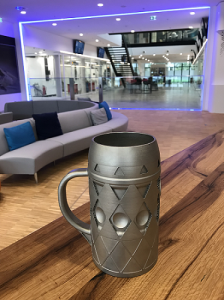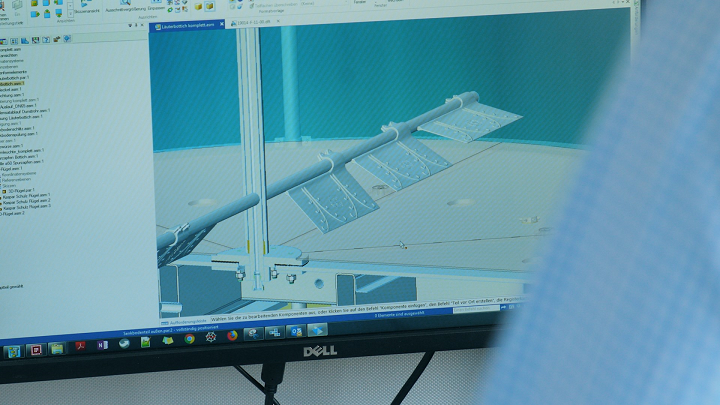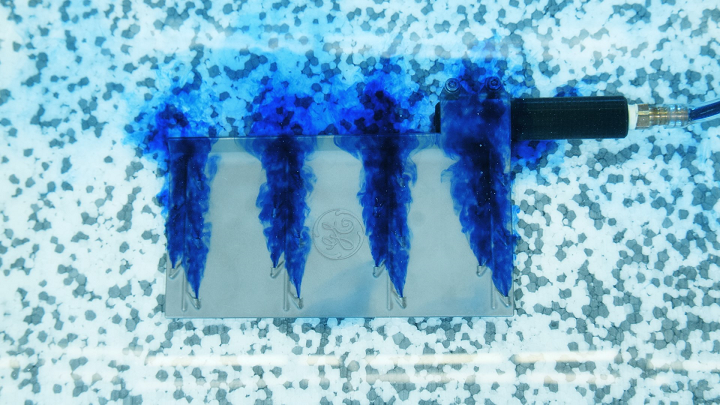From Christmas and New Year’s Eve to Halloween, the Fourth of July, and even Star Wars Day, we often see 3D printing used to enhance the holidays. But one holiday that seems to have been left out of the 3D printing fun – until recently – is Oktoberfest, an important part of Bavarian culture that takes place in Munich every autumn and has spawned similar celebrations all over the world; the town I grew up in has an Oktoberfest event, as does the city in which I currently live.
 Last year, just in time for Oktoberfest, the AddWorks team at the GE Additive Customer Experience Center in Munich created a limited edition 3D printed beer krug prototype, or Masskrug, out of stainless steel and titanium.
Last year, just in time for Oktoberfest, the AddWorks team at the GE Additive Customer Experience Center in Munich created a limited edition 3D printed beer krug prototype, or Masskrug, out of stainless steel and titanium.
This year, the company wanted to go even further for Oktoberfest, and explore what kind of potential 3D printing could have on the beverage and brewing industry. That’s why GE Additive’s CEC Munich team has spent the last six months working with Bamberg-based Kaspar Schulz GmbH, the world’s oldest brewing equipment manufacturer.
GE Additive asked its CEC Munich site leader Dr. Matthew Beaumont, along with advanced lead engineer Dr. Benedikt Roidl and Jörg Binkert, the head of Research & Development at Kaspar Schulz, to tell us about what the two companies have been brewing up.
First, the company wanted to know why Kaspar Schulz was specifically chosen, as there’s a pretty high concentration of breweries in Bamberg, which is often called Germany’s beer capital.
“We were looking for a partner for this project who was based nearby in Bavaria. Bamberg obviously offers a lot of possibilities with the large number of brewers and other companies associated with the brewing industry. Our Concept Laser facility is just down the road in Lichtenfels, and some of our team have connections to the Bamberg brewing scene, so – pardon the pun – we were able to tap into some local knowledge,” said Beaumont.
“We love working with early adopters in any industry, so the combination of a family business with a proven heritage of applying modern design, engineering and manufacturing made me think they would be great for this project.”
 Kaspar Schulz was founded back in 1677, and today, the tenth generation of the same family still runs the company. But, while it’s over 300 years old, Kaspar Schulz is still an innovative leader in its field, by adapting to new processes and technologies and passing the knowledge to its customers.
Kaspar Schulz was founded back in 1677, and today, the tenth generation of the same family still runs the company. But, while it’s over 300 years old, Kaspar Schulz is still an innovative leader in its field, by adapting to new processes and technologies and passing the knowledge to its customers.
“We were very pleased that GE Additive approached us,” Binkert said. “We were already familiar with 3D modelling and making designs with CAD, but additive manufacturing was something new for us. But once we started looking, it didn’t take us long to find a couple of good applications that could really be improved by using additive technology.”
GE Additive asked the three professionals why they chose to work on these two specific parts in particular for the project.
“Individually, the parts we worked on are great examples of two proven benefits of using additive manufacturing over traditional machining,” Beaumont explained.
Kaspar Schulz typically mills its access door knob out of stainless steel, which is also a technique frequently used in manufacturing aircraft. But 3D printing allowed the team to save on manufacturing time and material usage, in addition to customizing the part by adding a logo for no extra effort or cost.
“The racking blade design, however, was a chance for us to really show the freedom of design that additive allows,” Beaumont continued.
“At our first meeting, Mr. Binkert showed us some sketches of ideas that he had for improvements to the current racking arm for the lauter tun. His goal was to improve the filtration effect of the spent grain bed in the vessel in order to rinse it more thoroughly in order to save time and make it more efficient.
“Our team was quickly able to come up with a design to efficiently loosen the spent grains and inject water, throughout the bed, during rotation. The design of a thin blade that has internal channels to distribute water evenly is only achievable using additive manufacturing.”
GE Additive asked about any obstacles the team ran into along the way, and Beaumont responded that “time is always a challenge” when it comes to product development.
“We set the goal of achieving a first design in time for this year’s Oktoberfest, and we were able to do simulation analysis, complete the design, and perform basic functional tests before now.”
However, there are still some obstacles ahead, such as final use verification in the brewing process, and the ever important taste test by the team – obviously the most important part.
“It was amazing to see how many best practices the team at Kaspar Schulz has developed in the field of brewing, malting and distilling over the past 300 years,” Roidl said.
“Together with Mr. Binkert and his team, our specialists at the CEC in Munich evaluated how to improve the lautering process and we came up with the idea of dynamically loosening the spent grain using an induced swirling flow field.
“As Matthew says, we used additive to incorporate built-in channels to fluidize the spent grain – that’s a nice new little feature. We’ve also been able lean on our knowledge and expertise from the aerospace and other industries to new applications and industries – in this case the brewing industry.”
Binkert noted that the way the team now introduces water during the sparging process is “unique and without parallels.”
“We anticipate will be able to reduce time by 30% and even improve the yield,” he continued.
Finally, GE Additive asked how 3D printing could transform the brewing and beverage industry, and Beaumont said that it could have an “evolutionary effect” rather than a revolutionary one.
“Functional integration, reduction of the number of joints and seals are the quick wins that additive can offer without a massive change to the machinery. Beyond that, there can be incremental improvements to individual steps in the brewing process by taking advantage of the design freedom that additive allows. The racking blade is a great first example of that potential.”
Discuss this story and other 3D printing topics at 3DPrintBoard.com or share your thoughts in the Faceboook comments below.
[Source: GE Additive / Images: GE Additive/Slightvision]Subscribe to Our Email Newsletter
Stay up-to-date on all the latest news from the 3D printing industry and receive information and offers from third party vendors.
You May Also Like
3D Printing Unpeeled: New Arkema Material for HP, Saddle and Macro MEMS
A new Arkema material for MJF is said to reduce costs per part by up to 25% and have an 85% reusability ratio. HP 3D HR PA 12 S has been...
3D Printing News Briefs, January 20, 2024: FDM, LPBF, Underwater 3D Printer, Racing, & More
We’re starting off with a process certification in today’s 3D Printing News Briefs, and then moving on to research about solute trapping, laser powder bed fusion, and then moving on...
3D Printing Webinar and Event Roundup: December 3, 2023
We’ve got plenty of events and webinars coming up for you this week! Quickparts is having a Manufacturing Roadshow, America Makes is holding a Member Town Hall, Stratafest makes two...
Formnext 2023 Day Three: Slam Dunk
I’m high—high on trade show. I’ve met numerous new faces and reconnected with old friends, creating an absolutely wonderful atmosphere. The excitement is palpable over several emerging developments. The high...



































